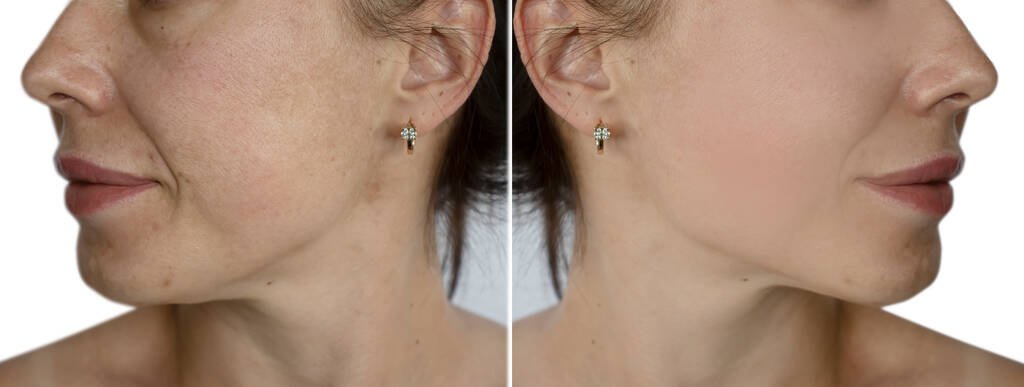Kybella is a brand name for synthetic deoxycholic acid. Deoxycholic acid is naturally produced by your digestive system. It helps to break down fats, making them easier to absorb. In addition, deoxycholic acid is employed as a food emulsifier. It is also a nonsurgical treatment option for lipomas, which are noncancerous tumors composed of fat cells. People frequently prefer Kybella because it requires less recovery time than surgery and hence has fewer dangers. Kybella shots are also an alternative for persons who are not suitable candidates for facial plastic surgery such as liposuction or neck lifts.
How does Kybella work?
The body naturally produces a moderate acid known as deoxycholic acid to aid with fat absorption. Kybella contains a synthetic version of this acid. When Kybella is injected, the deoxycholic acid destroys fat cells beneath the chin, preventing fat accumulation in the future. It is critical to choose a competent medical professional to deliver this treatment because the acid can potentially destroy normal cells. Before performing this in-office treatment, the Kybella physician will mark the injection sites and may provide a topical numbing cream or cold compress to guarantee the patient’s comfort. Patients commonly have 20 to 30 injections behind the chin, however the number of injections might reach 50. After being injected, the acid gradually destructs the fat cells, while the body eliminates these dead fat cells naturally over the next few months. Each patient requires a different amount of treatment sessions based on their individual needs. They may require repeated therapy sessions to achieve optimal outcomes. The patient can undergo up to six Kybella treatments, with a minimum of one month between each.
Preparing for Kybella
It is critical to discuss the Kybella therapy with your healthcare professional and ensure that you are a suitable candidate for the operation. Discuss your medical history, as well as any cosmetic treatments performed on your face, neck, or chin. Inform your healthcare practitioner if you are having trouble swallowing or bleeding. The study on Kybella’s effect on a fetus or newborn is still ongoing,
so tell your doctor if you are breastfeeding, pregnant, or intend to become pregnant in the near future. Kybella is a noninvasive surgery that requires very minimal preparation. It is best to plan the surgery well ahead of any significant activities. Washing your face correctly before the visit will help lower the chance of infection, and staying away from ibuprofen and acetaminophen can help prevent bruising after the procedure.
Kybella Treatment
The procedure is also known as injectable lipolysis since it breaks down fat using injections. Getting Kybella injections normally takes around 20 minutes. First, the health care practitioner numbs the region with ice or numbing cream. Then, with a marker, they outline the area under your chin in a grid-like design. They inject each dot using the same Kybella syringe. The shots are typically around a centimeter apart. The number of injections required depends on the amount of fat in your chin and the desired look; 20 shots are normal, but it might be up to 50. It should be painless.
How to Prepare for Your Kybella Treatment
Due to the risk of bruising, avoid scheduling it too close to an important event, such as a wedding. Plan it at least two to four weeks before the event.
-Do not schedule it if you are pregnant or intend to become pregnant, as no research has been conducted on how it would effect an unborn baby. Also, avoid scheduling it if you are breastfeeding.
-Reschedule your visit if you develop a rash or open sore in the treatment region.
-Avoid using strong cleaners, retinoid compounds, or bleaching lotions on your face two days before and after treatment.
What happens after Kybella?
When Kybella is injected into the fat beneath the skin, it destroys fat cells. After the fat cells are destroyed, immune cells known as macrophages enter. They remove the leftovers of the dead cells and encourage new collagen by recruiting fibroblasts. Fibroblasts are cells that contribute to the formation of connective tissue. Once the fat cells are removed, the area behind the chin will no longer store fat. Between that and tissue tightening, the double chin should disappear.
Are Kybella injections safe?
KYBELLA is an FDA-approved medicine that is believed to be safe for patients. However, like with any medication, there is a small risk of adverse side effects. There is a slight chance of nerve injury, which may cause a crooked smile or difficulties eating. However, in most situations, this damage is just temporary, and the nerves will eventually recover.
Does Kybella Really Work?
KYBELLA is one of the most direct and effective ways to target fat behind the chin. In 20 studies conducted around the world, more than 68.2% of participants reported a substantial reduction in fat compared to 20% who took a placebo. In addition, more than 79% of KYBELLA patients reported feeling better about the appearance of their faces after treatment.
Is Kybella permanent?
You’re undoubtedly thinking whether Kybella is a temporary solution or a permanent operation. What you should know is that because Kybella destroys fat cells, it is considered irreversible. Once fat cells die, they die. However, you can grow new fat cells.
Specifications of Kybella Treatment
The procedure is also known as injectable lipolysis since it breaks down fat using injections. Getting Kybella injections normally takes around 20 minutes. First, the health care practitioner numbs the region with ice or numbing cream. Then, with a marker, they outline the area under your chin in a grid-like design. They inject each dot using the same Kybella syringe. The shots are typically around a centimeter apart. The number of injections required depends on the amount of fat in your chin and the desired look; 20 shots are normal, but it might be up to 50. It should be painless.
Precautions for and after Kybella treatment?
Due to the risk of bruising, avoid scheduling it too close to an important event, such as a wedding. Plan it at least two to four weeks before the event.
•Do not schedule it if you are pregnant or intend to become pregnant, as no research has been conducted on how it would effect an unborn baby. •Also, avoid scheduling it if you are breastfeeding.
•Reschedule your visit if you develop a rash or open sore in the treatment region.
•Avoid using strong cleaners, retinoid compounds, or bleaching lotions on your face two days before and after treatment.
•Avoid anti-inflammatory or blood-thinning drugs and supplements such aspirin, ibuprofen, vitamin E, ginkgo biloba, ginseng, and fish oil. 10-14 days before therapy, and 3-4 days following.
•Avoid drinking for a week before treatment because it may thin the blood and increase the likelihood of bruising.
•Eat before treatment to lessen the possibility of lightheadedness.
•Before beginning treatment, remove your makeup, moisturizer, and facial sunscreen. Thoroughly wash your face and neck.
•Shave your beard before treatment.
•To avoid bruising, consider taking arnica tablets one week before treatment.
Kybella Side Effects
If you have symptoms of an allergic response to Kybella, such as hives, difficulty breathing, or swelling of your face, lips, tongue, or throat, seek emergency medical attention.
What other side effects of Kybella might a person experience?
•Trouble swallowing;
•You have weak facial muscles.
•A crooked smile.
•Open skin sores or discharge around treated regions;
•Pain, burning, inflammation, or skin changes where the injection was administered.
Common Kybella side effects could include
•Treatment regions may become numb or hardened.
•Hair loss around treated areas; or
•Pain, swelling, redness, or bruising in the treated areas.
Serious adverse effects of Kybella
Along with its desired advantages, deoxycholic acid (the active ingredient in Kybella) may produce some undesirable effects. Although not all of these side effects are likely to occur, if they do, medical treatment may be required. If you experience any of the negative symptoms listed below, contact your doctor right away. Symptoms may include headache, facial muscle weakness, pain in the mouth or throat, and pounding in the ears.
•Symptoms may include a slow or fast heartbeat, difficulty swallowing, and an odd smile.
•Blue-green to black skin. discoloration
•Symptoms may include skin cracking, fainting, neck ache, pain, redness, and sloughing at the injection site, as well as swelling, pain, or irritated lymph nodes in the neck.
Common side effects of Kybella
Some side effects of deoxycholic acid may occur, however they often do not require medical treatment. These adverse effects may subside during therapy as your body adapts to the medication. In addition, your health care expert may be able to advise you on how to avoid or mitigate some of these adverse effects.
•Bleeding, blistering, bruising, burning, coldness, skin discoloration, pressure, hives, infection, inflammation, itching, lumps, numbness, rash, scarring, soreness, stinging, swelling, tenderness, skin tightness, tingling, or warmth at the injection site.
What to Expect After Kybella
Your healthcare professional should create a treatment plan tailored to your individual circumstances. Most people require more than one Kybella treatment to achieve their desired aesthetic results. In clinical trials, many persons who received Kybella treatment had visible benefits after two to four doses. Six treatments were necessary in 59% of instances. Once deoxycholic acid eliminates fat cells in the submental area, the outcomes should be long-lasting, with no need for additional therapy because the fat cells can no longer store fat.
Recovery of Kybella
You can normally resume your normal activity level 24 hours after the operation. To relieve swelling, your doctor may recommend a compression garment.? If they are self-conscious about the swelling, they may choose to stay at home until it subsides. Others may choose to wear a scarf or a turtleneck sweater when going out. You should anticipate to see results in 6 to 8 weeks following the operation, but it may take up to 12 weeks to see the best results. You will notice skin tightening in the chin area, as well as a reduction in the appearance of double chin.
Caring advice after Kybella treatment
•For 24 hours, avoid intense heat sources (such as hot showers and saunas).
•To decrease swelling, don’t drink alcohol for three days.
•Do not exercise vigorously for 24 to 48 hours, as this can exacerbate swelling.
•If you find that cold packs help with pain management, use them for the first 12 hours.
•Take acetaminophen for pain as directed. Consult your doctor before taking ibuprofen.
•Do not rub the region where you received the shot because this will aggravate it further.
•Take arnica pills to help decrease bruising. •Sleep on your back, with your head elevated on a couple of
outcomes should be long-lasting, with no need for additional therapy because the fat cells can no longer store fat.
Conclusion
Kybella is a nonsurgical injectable treatment used to reduce fat under the chin. The procedure involves a series of deoxycholic acid injections to target the fat cells in this location. There are no incisions necessary, and downtime is short in most circumstances. The ideal candidate is an adult aged 18 or older who has moderate to severe fat behind the chin. You may not be a good candidate if you have had or want to have facial surgery, have difficulty swallowing, are pregnant or nursing, or have an illness or medical condition in or near the planned injection site. In short, Kybella is a man-made version of a chemical produced by your body that aids in fat absorption. Deoxycholic acid destroys fat cells when injected into the body. Kybella injections are used to reduce the appearance of fat beneath the chin, sometimes known as a double chin.


